You are in: Africa -> South Africa -> Cape Floral Region P... , and traditional search or Image Gallery will yield results of this site only
Cape Floral Region Protected Areas
| Site number: | 1007 |
|
| Type of site: | Natural | |
| Date: | - | |
| Date of Inscription: | 2004 | |
| Location: | Africa, South Africa, Western Cape Province, Eastern Cape Province | |
Up to 75 images are shown here. Click on each for more details or on Image Gallery for more images.
| Description: | A 553,000-ha serial site is made up of eight protected areas, located in Cape Province, South Africa. The Cape Floral Region is one of the world’s most affluent plant areas. Representing less than 0.5% of the area of Africa, it is habitat to almost 20% of the continent’s flora. The site exhibits exceptional ecological and biological processes of the Fynbos vegetation (unique in the Cape Floral Region); it has the highest worldwide diversity, density and endemism of this flora. Of outstanding value to science are the site’s unique reproductive strategies of plants, adaptive to fire, seed dispersal patterns of insects, as well as patterns of endemism and acclimatizing radiation found in the flora. --WHMNet paraphrase from the description at WHC Site, where additional information is available. | |
| Fynbos (IPA /ˈfəinbɒs/, or anglicised with /fɛin-/, meaning "fine bush" in Afrikaans) is the natural shrubland or heathland vegetation occurring in a small belt of the Western Cape of South Africa, mainly in winter rainfall coastal and mountainous areas with a Mediterranean climate. Fynbos grows in a 100-200km wide coastal belt stretching from Clanwilliam on the West coast to Port Elizabeth on the Southeast coast. It forms part of the Cape floral kingdom, where it accounts for half of the surface area and 80% of the plant varieties. The fynbos in the Western regions is more rich and varied than in the Eastern regions. Of the world's six floral kingdoms, this is the smallest and richest per area unit. Contrast it in size with the Holarctic kingdom, which incorporates the whole of the northern hemisphere apart from the tropical regions. The diversity of fynbos plants is greater than that of the tropical rainforests, with over 9000 species of plants occurring in the area, around 6200 of which are endemic, i.e. do not occur anywhere else in the world. Of the Ericas, 600 occur in the fynbos kingdom, while only 26 are found in the rest of the world. This is in an area of 46,000 km² - by comparison, the Netherlands, with an area of 33,000 km², has 1400 species, none of them endemic. Table Mountain in Cape Town supports 2200 species, more than the entire United Kingdom. Thus although the Fynbos comprises only 6% of the area of southern Africa it has half the species on the subcontinent, and in fact has almost 1 in 5 of all plant species in Africa. Large parts of the fynbos region have been developed for agriculture or through the urban expansion around Cape Town. Fynbos areas are also threatened by the spread of alien species, in particular wattle and acacia species from Australia, as well as pine plantations. Many species have gone extinct, and more than 1000 are endangered. Their conservation is a priority, and reserves have been established in many areas. --Wikipedia. Text is available under the Creative Commons Attribution-ShareAlike License. | ||
| The Hill Forts of Rajasthan are a series of sites located on rocky outcrops of the Aravallis mountain range in Rajasthan. They represent a typology of Rajput military hill architecture, a style characterized by its mountain peak settings... --Wikipedia. Text is available under the Creative Commons Attribution-ShareAlike License. | ||
| Source: | http://whc.unesco.org/en/list/1007 | |
| Reference: | 1. UNESCO World Heritage Center, Site Page. | |
















